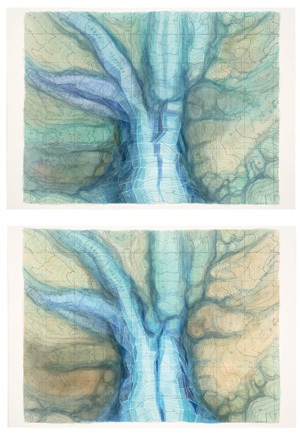Glacial Speed first appears to comprise the same topographic map reprinted 80 times. The contours of brown and green are about the same in each watercolor reproduction. Look more carefully at the channel of blue–initially big, branching, robust–and you’ll apprehend the dwindling river of ice. (The actual location isn’t divulged, but looks to be Montana’s Glacier National Park.) A companion video lets you watch the whole sequence in animated form, but the wall of melting documentation is more impressive. Glacial Speed isn’t didactic environmental art; still, it forces you to think about natural processes. The ice, like Camlin’s watercolor technique, is also a fluid medium; it can move forward and back, but never remain frozen in place (as the video makes clear). Substitute red for blue, blood for ice, and the flow could resemble arteries thinning with age. Mountain climbers say ice is either “fat” (healthy) or thin. In Camlin’s reiterations, like the CT scans of a hospital patient, the Sheep Glacier appears headed toward ill-health, perhaps death. BRIAN MILLER
Thu., June 2, 5-8 p.m.; Thursdays-Saturdays, 12-5 p.m. Starts: June 2. Continues through July 2, 2011





